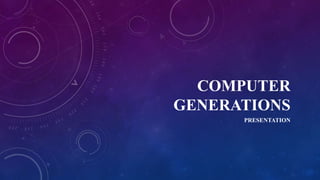
Computer generations
- 2. INTRODUCTION: • The first electronic computer was designed and built at the University of Pennsylvania based on vacuum tube technology. • Vacuum tubes were used to perform logic operations and to store data. • Generations of computer has been divided into five according to the development of technologies.
- 3. GENERATION: “Generation in computer terminology is a change in technology a computer is/was being used. Initially, the generation term was used to distinguish between varying hardware technologies. But nowadays, generation includes both hardware and software, which together make up an entire computer system.”
- 4. COMPUTER GENERATIONS: Following are the five generation of computers: 1. 1st Generation – Vacuum based(1942-54) 2. 2nd Generation – Transistor based(1952-64) 3. 3rd Generation – IC based(1964-72) 4. 4th Generation – VLSI microprocessor based(1972-90) 5. 5th Generation – ULSI microprocessor based(1990-onwards)
- 5. FIRST GENERATION(1942-54): TECHNOLOGY – VACUUM TUBES • First generation of computer started with using vacuum tubes as the basic components for memory and circuitry for CPU(Central Processing Unit). • The vacuum tube is a glass tube that has its gas removed, creating a vacuum. Vacuum tubes contain electrodes for controlling electron flow and were used in early computers as a switch or an amplifier. • In this generation mainly batch processing operating system were used. Punched cards, Paper tape, Magnetic tape Input & Output device were used.
- 6. FIRST GENERATION: • There were Machine code and electric wired board languages used. • Size of computer – as big as a room. • Special rooms required – ventilation. DRAWBACKS: • Vacuum tube technology and Unreliable • Supported Machine language only • Very costly • Generate lot of heat
- 7. FIRST GENERATION: • Slow Input/ Output device • Huge size & Non portable • Consumed lot of electricity • Need of A.C. EXAMPLES: • ENIAC (electronic numerical integrator and collector) • UNIVAC 1st successful machine launched. - better. - based on the theory.
- 8. 2ND GENERATION(1952-64): TECHNOLOGY – TRANSISTOR • This generation using the transistor were cheaper, consumed less power, more compact in size, more reliable and faster than the first generation machines made of vacuum tubes. • In this generation, magnetic cores were used as primary memory and magnetic tape and magnetic disks as secondary storage devices. • In this generation assembly language and high level programming language like FORTRAN, COBOL were used.
- 9. 2ND GENERATION: • There were Batch processing and Multiprogramming Operating system used. ADVANTAGES: • 200 transistors are about the size same as of 1 vacuum tube – technology size 200 times reduce. • 40 times faster. • Less expensive than vacuum tube. • Don’t burn out like vacuum tube.
- 10. 2ND GENERATION: • Support machine and assembly languages (high level language) DRAWBACKS: • Cooling system was required. • Constant maintenance was required. • They were expensive. EXAMPLES: • IBM 7094 • IBM 1400 • CDC 164 etc.
- 11. 3RD GENERATION(1964-72): TECHNOLOGY – IC • The third generation of computer is marked by the use of Integrated Circuits (IC's) in place of transistors. • A single I.C has many transistors, resistors and capacitors along with the associated circuitry. • This development made computers smaller in size, reliable and efficient. • In this generation Remote processing, Time- sharing, Real-time, Multi-programming Operating System were used.
- 12. 3RD GENERATION: • High level language (FORTRAN-II TO IV, COBOL, PASCAL PL/1, BASIC, ALGOL-68 etc.) were used during this generation. ADVANTAGES: • Smaller size and more reliable. • Faster than previous computers. • Less expensive • Support high level language. • More accurate than previous.
- 13. 3RD GENERATION: DRAWBACKS: • IC chips are difficult to maintain • Highly sophisticated technology is required for the manufacturing of IC circuits. • Air conditioning is required. EXAMPLES: • IBM system 360 • PDP-8
- 14. 4TH GENERATION(1972-90): TECHNOLOGY – MICROPROCESSOR • The fourth generation of computers is marked by the use of Very Large Scale Integrated (VLSI) circuits. • VLSI circuits having about 5000 transistors and other circuit elements and their associated circuits on a single chip made it possible to have microcomputers of fourth generation. • Fourth Generation computers became more powerful, compact, reliable, and affordable. As a result, it gave rise to personal computer (PC) revolution.
- 15. 4TH GENERATION: • In this generation Time sharing, Real time, Networks, Distributed Operating System were used. All the Higher level languages like C and C++, DBASE etc. were used in this generation. ADVANTAGES: • Very cheap, portable and reliable. • Very small size as compared to others • Concept of internet was introduced. • Developments in the field of networking • Computers became easily available.
- 16. 4TH GENERATION: DRAWBACKS: • Cooler is required (fan) • Latest technology is required to make microprocessors. EXAMPLES: • CRAY-1(super computer) • CRAY-X-MP(super computer)
- 17. FIFTH GENERATION: • Artificial intelligence ULSI (robotics, neural networks, game playing etc) • Latest • In the development stage (not completed yet)
- 18. THANK YOU